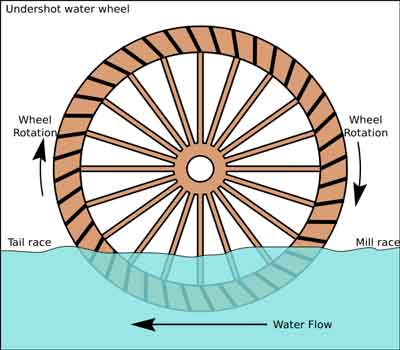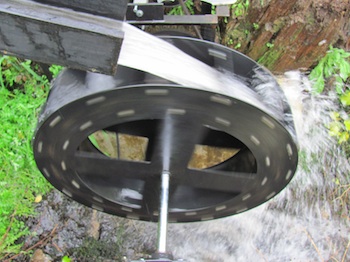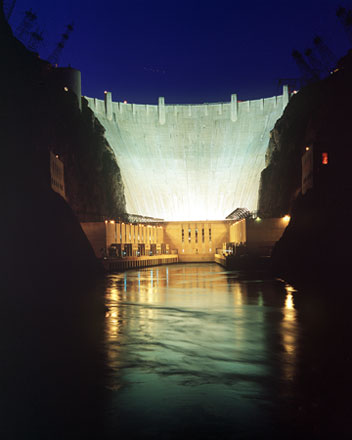3.1: Basics of Electricity Production from Steam Turbines
- Page ID
- 48553
3.1 Basics of Electricity Production from Steam Turbines
History
There were several people who tried to use steam pressure to produce some sort of mechanical energy, but they were not really able to accomplish this (including Watt, 1769; von Kempelen, 1784; Trevithick, early 1800s). The first steam turbine was developed by De Laval in the 1870s - his device was used to separate cream from milk. However, Charles Parsons was the first to use steam as the working fluid for electricity generation.
Mechanics
The overall goal is to move an electric generator in a circular fashion, which can be done with a turbine. In order for a turbine to be driven, a working fluid must be used. Water can be used for driving a turbine for electricity - it is known as hydroelectricity. Figure 3.1a shows the schematic of a water wheel and how it works, and Figure 3.1b shows a picture of a modern turbine. A turbine uses the force of water (and windmills work on this principle too) to turn a wheel (or turbine). The turning turbine can be used to move something else, like something that will grind wheat into flour.


A working fluid must meet certain criteria. It must be:
- cheap;
- available, or able to be produced in large quantities;
- reasonably safe and environmentally friendly.
One of the few substances that meets this criteria is water. However, since we don't have unlimited waterfalls to produce hydroelectricity, the next best thing is "gaseous water," or steam. And to produce electricity, we want the turbine to turn very fast, and the way to do that is with high-pressure steam.
The way to produce high-pressure steam is based on Boyle's Law: For a fixed quantity of gas held at a constant temperature, pressure times the volume equals a constant (P*V = constant). For this application, Boyle's Law becomes important when combined with the work of Charles and Gay-Lussac, where volume is proportional to temperature. Therefore, for a fixed quantity of gas at constant pressure, then P*V = (constant)*T. If the volume is held constant, and temperature increases, then the pressure will increase as well. The key to producing high-pressure steam is to produce high-temperature steam. If high-pressure and high-temperature steam is fed to a turbine, the steam is allowed to expand across the turbine, and the volume increases. During expansion, as the volume increases, the pressure drops, which in turn causes the temperature to drop. Figure 3.2a is a schematic that summarizes how the steam plays a role in the turbine.

Credit: Dr. Caroline B. Clifford

Credit: Dr. Caroline B. Clifford
When the turbine is connected to a generator, then electricity is produced. A generator is a coil of wire that is spun very quickly around a set of magnets. So, if we add a generator to the turbine.... (see Figure 3.2b) As seen in Figure 3.1, water can be used to turn a turbine, which then turns the generator for electricity. An example of a hydroelectric plant is the one at Hoover Dam in Nevada (see Figure 3.3).

Credit: Bureau of Reclamation, Andrew Pernick, Photographer
Almost 99% of our electricity comes from generators. In the past, 12-15% of electricity was produced by hydroelectric facilities, but that number has gone down to 6-9%. Hydroelectricity is limited by location (waterfalls), therefore electricity has to come from another source. The remaining 85-94% comes from electricity plants in which steam is used as the working fluid in the turbine. So, how do we do this as cheaply and reliably as we can? Steam is the working fluid that is used, so now we'll go into how we do this.


